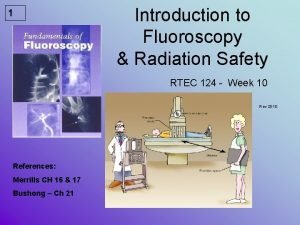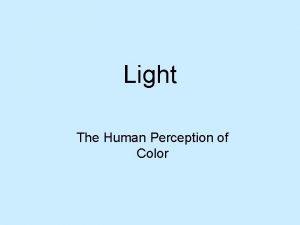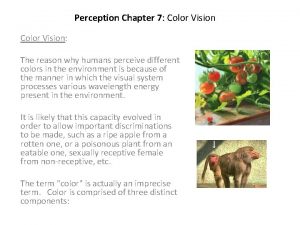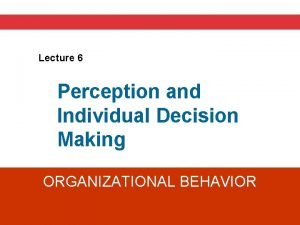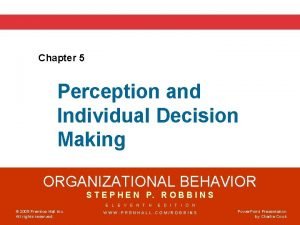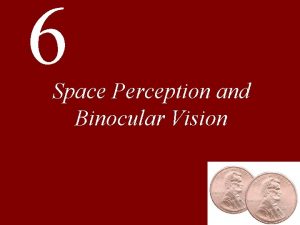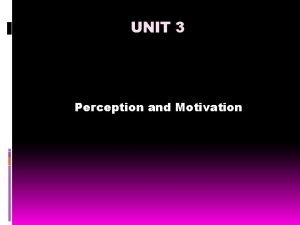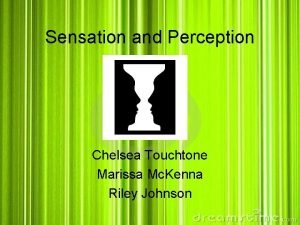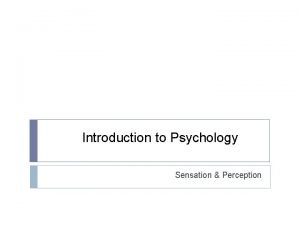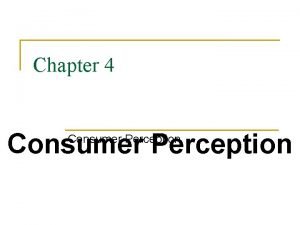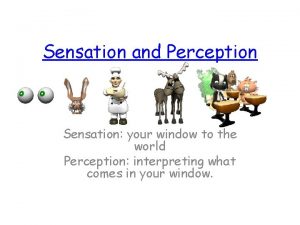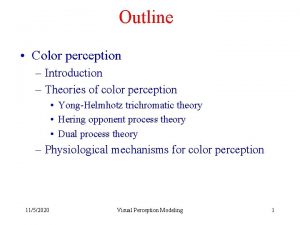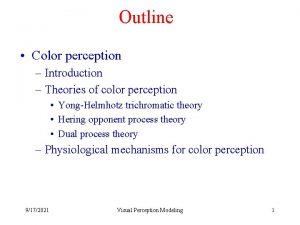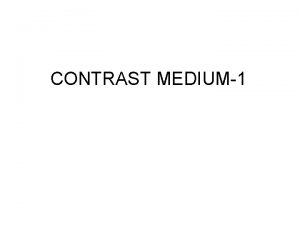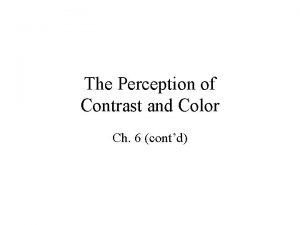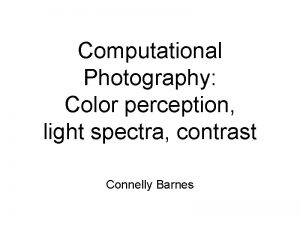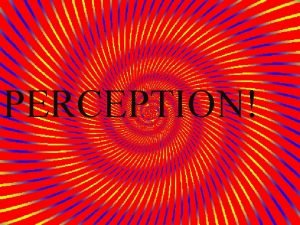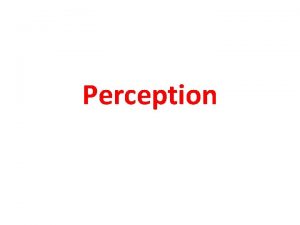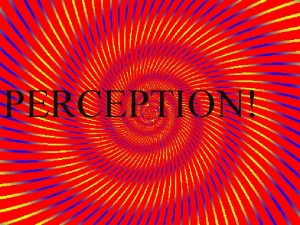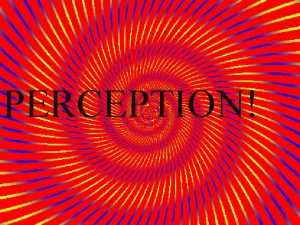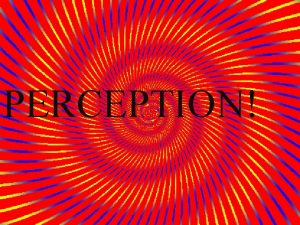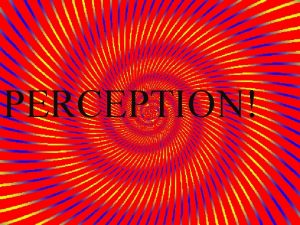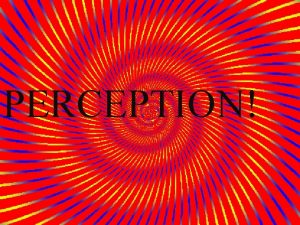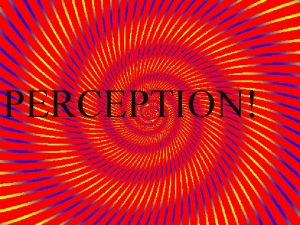The Perception of Contrast and Color Ch 6

































































- Slides: 65

The Perception of Contrast and Color Ch. 6 (cont’d)

Outline • Contrast: The Perception of Edges • Brightness-Contrast Detectors in the Mammalian Visual System • Seeing Color

Contrast: The Perception of Edges

Contrast: The Perception of Edges • Edges are the most important stimuli in our visual world; they define the position and extent of things • Edge perception is the perception of a contrast between two adjacent areas of the visual field; this lecture will focus on how the visual system controls brightness contrast

Contrast: The Perception of Edges • The perception of edges is so important that there is a mechanism in the visual system that enhances our perception of brightness contrast; this is called contrast enhancement; thus what we see is even better than the physical reality

Contrast: The Perception of Edges • The Mach bands illusion is the result of contrast enhancement; in it, light areas that are near the border with a dark region appear lighter than they really are, and the area of the dark region that lies along this border looks darker than it really is

Lateral Inhibition: The Physiological Basis of Contrast Enhancement • The mechanisms of contrast enhancement were studied in the eye of the horseshoe crab because of its simplicity; it is a simple compound eye, with eye of its individual receptors (ommatidia) connected by a lateral neural network (the lateral plexus)

Lateral Inhibition: The Physiological Basis of Contrast Enhancement • When ommatidium is activated, it inhibits neighbors via the lateral plexus; contrast enhancement occurs because receptors near an edge on the dimmer side receive more lateral inhibition than receptors further away from the edge…

Lateral Inhibition: The Physiological Basis of Contrast Enhancement • …while receptors near the edge on the brighter side receive less lateral inhibition than the receptors on the brighter further way from the edge

Brightness-Contrast Detectors in the Mammalian Visual System

Mapping Receptive Fields • In the late 1950’s Hubel and Wiesel developed a method that became the standard method for studying visual system neurons

Mapping Receptive Fields • Visual stimuli are presented on a screen in front of a subject (cat or monkey); the image is artificially focused on the retina by an adjustable lens in front of the eye

Mapping Receptive Fields • Once an extracellular electrode is positioned in the neural structure of interest so that it is recording the action potentials of only one neuron, the neuron’s receptive field is mapped; the receptive field of a neuron is the area of the visual field within which appropriate visual stimuli can influence the firing of that neuron

Mapping Receptive Fields • Once the receptive field is defined, the task is to discover what particular stimuli presented within the field are most effective in changing the cell’s firing

Receptive Fields of Neurons in the Retina-Geniculate-Striate Pathway • Most retinal ganglion cells, lateral geniculate nucleus neurons, and the neurons in lower layer IV of the striate cortex have similar receptive fields: they are smaller in the foveal area; they are circular; they are monocular; and they have both an excitatory and an inhibitory area separated by a circular boundary

Receptive Fields of Neurons in the Retina-Geniculate-Striate Pathway • Neurons in these regions have 2 patterns of responding: (1) on firing; or (2) inhibition followed by off firing

Receptive Fields of Neurons in the Retina-Geniculate-Striate Pathway • The most effective way to influence the firing of these neurons is to fully illuminate only the “on area” or the “off area” of its receptive field; if one light is shone in the “on area” and one is simultaneously shone in the “off area”, their effects cancel one another out by lateral inhibition; these neurons respond little to diffuse light

Receptive Fields of Neurons in the Retina-Geniculate-Striate Pathway • In effect, many neurons of the retinageniculate-striate pathway respond to brightness contrast between the centers and peripheries of their visual fields

Brightness-Contrast Detectors in the Mammalian Visual System

Mapping Receptive Fields • In the late 1950’s Hubel and Wiesel developed a method that became the standard method for studying visual system neurons

Simple Cortical Cells • Simple cortical cells in the striate cortex have receptive fields like those that were just described, except that the two areas of the receptive fields are divided by straight lines

Simple Cortical Cells • These cells respond best to bars or edges of light in a particular location in the receptive field and in a particular orientation (e. g. , 45 degrees) • All simple cells are monocular

Complex Cortical Cells • Most of the cells in the striate cortex are complex cells; they are more numerous but are like simple cells in that they respond best to straight-line stimuli in a particular orientation; they are not responsive to diffuse light

Complex Cortical Cells • Complex cells are unlike simple cells in that the position of the stimulus within the receptive field does not matter; the cell responds to the appropriate stimulus no matter where it is in its large receptive field • Over half of the complex cells are binocular, and about half of those that are binocular display ocular dominance

Hubel and Wiesel’s Model of Striate-Cortex Organization • When you record from visual cortex using vertical electrode passes, you find: (1) cells with receptive fields in the same part of the receptive field, (2) simple and complex, cells that all prefer the same orientation, and (3) binocular complex cells that are all dominated by the same eye (if they display ocular dominance)

Hubel and Wiesel’s Model of Striate-Cortex Organization • When you record visual cortex using horizontal electrode passes you find: (1) receptive field location shifts slightly with each electrode advance, (2) orientation preferences shifts slightly with each electrode advance and (3) ocular dominance periodically shifts to the other eye with electrode advances

Hubel and Wiesel’s Model of Striate-Cortex Organization • Ocular dominance columns can be visualized by injecting a large does of radioactive amino acids in one eye, waiting several days, and then subjecting the cortex to audioradiography; ocular dominance columns are clearly visible in lower layer IV as alternating patches of radioactivity and non-radioactivity

Hubel and Wiesel’s Model of Striate-Cortex Organization • Columns of vertical-line-preferring neurons have been visualized by injecting radioactive 2 -DG and then moving vertical stripes back and forth in front of the animal for 45 min. ; the subjects were then immediately killed and their brains sectioned; columns of radioactivity were visible through all layers of striate cortex except lower layer IV

(In-class Video)

Seeing Color

Component Theory • Also called trichromatic theory • Component processing occurs at receptor level • One of three different photopigments coats each cone; each photopigment reacts optimally to a particular part of the spectrum of electromagnetic energy; the ratio of cones activated at a particular part of the color spectrum creates a summed stimulus and thus color differentiation

Opponent Process Theory • Opponent processing occurs at all levels of the visual system beyond the receptors • Three classes of cells: one that becomes more active to red and less active to green; one that becomes more active to blue and less to yellow; and one that is more active to bright and less active to dark areas

Opponent Process Theory • With regards to color vision, red-green and blue-yellow opponent cells fire in response to input from cones; when red cells are “on” one cannot see green and when yellow cells are “on” one cannot see blue

Color Constancy • This is the tendency for an object to be perceived as the same color despite major changes in wavelengths of light that it reflects • Perception of color constancy allows objects to be distinguished in a memorable way

Color Constancy • Retinex theory of color vision follows the premise that the color of an object is determined by its reflectance and the visual system calculates the reflectance of surfaces by comparing the ability of a surface to absorb light in the three bandwidths corresponding to the three classes of cones

Color Constancy • Dual-opponent cells provide the means to analyze contrast between wavelengths reflected by adjacent areas of their receptive fields

Cortical Mechanisms of Vision and Audition Ch. 7

Outline • General Concepts (hierarchy, sensation and perception) • Cortical Mechanisms of Vision • The Auditory System

The Traditional Hierarchical Sensory-System Model • Traditionally, sensory-system organization has been viewed according to the following model: input flows from receptors to thalamus, to primary sensory cortex, to secondary sensory cortex, and finally to associated cortex

The Traditional Hierarchical Sensory-System Model • Primary sensory cortex is cortex that receives direct input from the thalamic sensory relay nuclei • Secondary sensory cortex is cortex that receives input primarily from the primary cortex • Associated cortex is cortex that receives input from more than one sensory system

The Traditional Hierarchical Sensory-System Model • The major feature of this model is its serial and hierarchical organization (any system with components that can be assigned ranks) • Sensory systems are thought to be hierarchical in two ways:

The Traditional Hierarchical Sensory-System Model (1) Sensory info is thought to flow through brain structures in order of their increasing neuroanatomical complexity (2) Sensation is thought to be less complex than perception

The Traditional Hierarchical Sensory-System Model • The neuroanatomical hierarchy is thought to be related to the functional hierarchy; perception is often assumed to be a function of cortical structures

Sensation and Perception • Sensation refers to the simple process of detecting the presence of a stimulus • Perception refers to the complex process of integrating, recognizing, and interpreting complex patterns of sensations

The Current Model of Sensory. System Organization • It is now clear that sensory systems are characterized by a parallel, functionally segregated, hierarchical organization

The Current Model of Sensory. System Organization • Parallel: sensory systems are organized so that information flows between different structures simultaneously along multiple pathways • Functionally segregated: sensory systems are organized so that different parts of the various structures specialize in different kinds of analysis • Hierarchical: as noted, information flows through brain structures in order of their increasing neuroanatomical and functional complexity

The Current Model of Sensory. System Organization • The Critical Question: If different types of information are processed in different specialized zones that are found in different structures connected by multiple pathways, how are complex stimuli perceived as an integrated whole? This is known as the binding problem

Cortical Mechanisms of Vision • The occipital cortex and some of the parietal and temporal cortex is visual cortex • Primary visual cortex is in the occipital lobe; secondary visual cortex is in the prestriate cortex (surrounding primary) and inferotemporal cortex; and most of the visual association cortex is posterior parietal cortex

Scotomas and Blindsight • Individuals with damage to primary visual cortex have scotomas or areas of blindness in corresponding areas of the visual field • Amazingly, when forced to guess, some brain-damaged patients can respond to stimuli in their scotomas (e. g. , can grab a moving object or guess the direction of its movement) all the while claiming to see nothing; this is called blindsight

Scotomas and Blindsight • Blindsight is thought to be mediated by visual pathways that are not part of the retina-geniculate-striate system; one hypothesis is that the r-g-s system mediates pattern and color perception, whereas a system involving the superior colliculus and the pulvinar nucleus of the thalamus mediates the detection and localization of objects in space

Scotomas and Blindsight • This phenomenon emphasizes that parallel models (multiple-path) models rather than serial models (single-path) are needed to explain many perceptual phenomena

Secondary Visual Cortex and Associated Cortices • Visual information is believed to flow along two anatomically and functionally distinct pathways: – Dorsal stream – Ventral stream

Secondary Visual Cortex and Associated Cortices • Dorsal Stream: information flows from primary visual cortex through the dorsal prestriate secondary visual cortex to association cortex in the posterior parietal region • Ventral Stream: info flows from primary visual cortex through the ventral prestriate secondary cortex to association cortex in the inferotemporal region

Secondary Visual Cortex and Associated Cortices • Traditionally, the dorsal stream was believed to be involved in the perception of where objects are, while the ventral stream was believed to be involved in the recognition of that object (a what system)

Secondary Visual Cortex and Associated Cortices • More recently, it’s been proposed that the dorsal stream is actually involved in directing behavioral interactions with objects (which would include, but not be restricted to, analyses of where objects are; a behavioral control path), while the ventral stream is responsible for the conscious recognition of objects ( a conscious perception path)

Visual Agnosia • Agnosia is a failure to recognize that something that is not attributable to a simple sensory deficit, or to motor, verbal, or intellectual impairment

Visual Agnosia • Prosopagnosia, the inability to recognize faces, is the most interesting and most common form of visual agnosia; they can readily perceive chairs, tables, hats, but not faces • Often can’t recognize own face in mirror

Visual Agnosia • This has led to the view that there is a special area in the brain for the recognition of faces and it is damaged in prospagnosics; the finding of neurons in inferotemporal cortices of monkeys that respond only to conspecific faces supports this view

Visual Agnosia • However, some patients lost ability to perceive specific birds, cows, etc. • Prosopagnosia may not be specific to faces; may be difficulty in distinguishing between visually similar members of complex classes of visual stimuli

Auditory System

The Ear • Vibrations in the air are transmitted through the tympanic membrane (ear drum), ossicles (three small bones) and oval window into the fluid of the cochlea • The vibrations bend the organ of Corti and excite hair cells in the basilar membrane • The organization of the organ of Corti is tonotopic; higher frequencies excite receptors closer to the oval window, thus with exposure to noise, damage to the high frequency receptors occurs first

Auditory Projections • Unlike the visual system, there is no one major auditory projection • Hair cells synapse onto neurons whose axons enter the metencephalon and synapse in the ipsilateral cochlear nucleus

Auditory Projections • From the cochlear nucleus some fibers project to the nearby superior olives, which projects to the inferior colliculus via the lateral lemniscus • From the inferior colliculus, fibers ascend to the medial geniculate nucleus of the thalamus; and from there, fibers ascend to the primary cortex in the lateral fissure • The projections from each ear are bilateral

Auditory Cortex • The auditory cortex is located in the lateral fissure that separates the temporal and frontal lobes • It is tonotopically organized • In addition, it is organized into functional columns such that neurons in a given column all respond maximally to tones in the same frequency range

Auditory Cortex • Bilateral lesions of auditory cortex do not cause deafness, even if the lesions include secondary auditory cortex • Humans with extensive auditory cortex damage often have difficulty localizing brief stimuli or recognizing rapid complex sequences of sounds
 Double contrast vs single contrast
Double contrast vs single contrast Color perception examples
Color perception examples Successive color contrast
Successive color contrast Hát kết hợp bộ gõ cơ thể
Hát kết hợp bộ gõ cơ thể Frameset trong html5
Frameset trong html5 Bổ thể
Bổ thể Tỉ lệ cơ thể trẻ em
Tỉ lệ cơ thể trẻ em Voi kéo gỗ như thế nào
Voi kéo gỗ như thế nào Tư thế worm breton là gì
Tư thế worm breton là gì Chúa yêu trần thế
Chúa yêu trần thế Kể tên các môn thể thao
Kể tên các môn thể thao Thế nào là hệ số cao nhất
Thế nào là hệ số cao nhất Các châu lục và đại dương trên thế giới
Các châu lục và đại dương trên thế giới Công thức tính độ biến thiên đông lượng
Công thức tính độ biến thiên đông lượng Trời xanh đây là của chúng ta thể thơ
Trời xanh đây là của chúng ta thể thơ Mật thư tọa độ 5x5
Mật thư tọa độ 5x5 Phép trừ bù
Phép trừ bù Phản ứng thế ankan
Phản ứng thế ankan Các châu lục và đại dương trên thế giới
Các châu lục và đại dương trên thế giới Thể thơ truyền thống
Thể thơ truyền thống Quá trình desamine hóa có thể tạo ra
Quá trình desamine hóa có thể tạo ra Một số thể thơ truyền thống
Một số thể thơ truyền thống Cái miệng bé xinh thế chỉ nói điều hay thôi
Cái miệng bé xinh thế chỉ nói điều hay thôi Vẽ hình chiếu vuông góc của vật thể sau
Vẽ hình chiếu vuông góc của vật thể sau Thế nào là sự mỏi cơ
Thế nào là sự mỏi cơ đặc điểm cơ thể của người tối cổ
đặc điểm cơ thể của người tối cổ V cc cc
V cc cc Vẽ hình chiếu đứng bằng cạnh của vật thể
Vẽ hình chiếu đứng bằng cạnh của vật thể Vẽ hình chiếu vuông góc của vật thể sau
Vẽ hình chiếu vuông góc của vật thể sau Thẻ vin
Thẻ vin đại từ thay thế
đại từ thay thế điện thế nghỉ
điện thế nghỉ Tư thế ngồi viết
Tư thế ngồi viết Diễn thế sinh thái là
Diễn thế sinh thái là Dạng đột biến một nhiễm là
Dạng đột biến một nhiễm là Bảng số nguyên tố lớn hơn 1000
Bảng số nguyên tố lớn hơn 1000 Tư thế ngồi viết
Tư thế ngồi viết Lời thề hippocrates
Lời thề hippocrates Thiếu nhi thế giới liên hoan
Thiếu nhi thế giới liên hoan ưu thế lai là gì
ưu thế lai là gì Hươu thường đẻ mỗi lứa mấy con
Hươu thường đẻ mỗi lứa mấy con Khi nào hổ con có thể sống độc lập
Khi nào hổ con có thể sống độc lập Hệ hô hấp
Hệ hô hấp Từ ngữ thể hiện lòng nhân hậu
Từ ngữ thể hiện lòng nhân hậu Thế nào là mạng điện lắp đặt kiểu nổi
Thế nào là mạng điện lắp đặt kiểu nổi Romeo and juliet and west side story comparison
Romeo and juliet and west side story comparison Chapter 5 sensation and perception
Chapter 5 sensation and perception Color vision
Color vision Sejarah papi kostick
Sejarah papi kostick Perception and individual decision making
Perception and individual decision making Reversible figure ground relationship
Reversible figure ground relationship A subjective perception of vitality and feeling well
A subjective perception of vitality and feeling well Perception and individual decision making
Perception and individual decision making Subjective perception of vitality and feeling well
Subjective perception of vitality and feeling well Perceptual set ap psych
Perceptual set ap psych Crossed disparity
Crossed disparity Perception and motivation
Perception and motivation Sensation vs perception
Sensation vs perception Sensation and perception crossword review answers
Sensation and perception crossword review answers Chapter 3 sensation and perception
Chapter 3 sensation and perception Sensation and perception
Sensation and perception Chapter 6 sensation and perception
Chapter 6 sensation and perception Copyright
Copyright Absolute threshold consumer behavior
Absolute threshold consumer behavior Webers law
Webers law Sensation and perception
Sensation and perception
